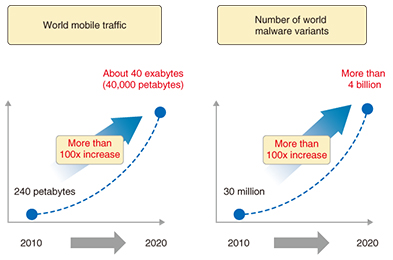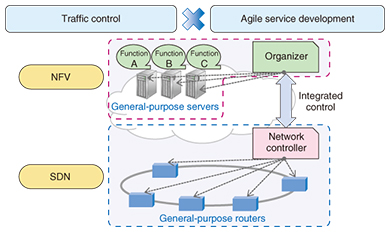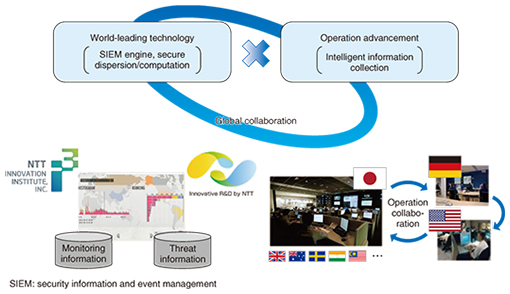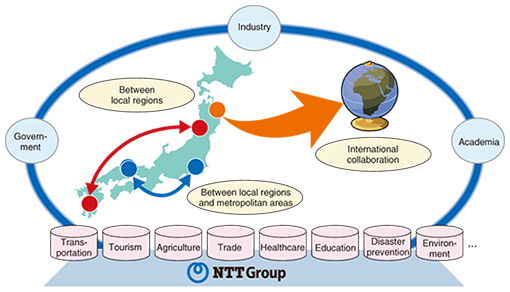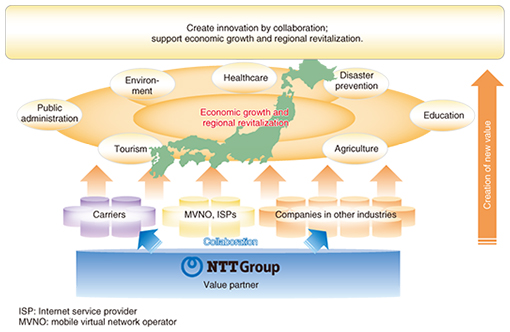 |
|||
|
|
|||
|
Feature Articles: Keynote Speeches at NTT R&D Forum 2015 Vol. 13, No. 4, pp. 1–8, Apr. 2015. https://doi.org/10.53829/ntr201504fa1  Value Creation by CollaborationOverviewThis article introduces NTT Group initiatives towards 2020 centered on global cloud business and network services. The content of this article is based on the keynote lecture presented by NTT Representative Director, President and Chief Executive Officer Hiroo Unoura at NTT R&D Forum 2015 held February 19–20, 2015. Keywords: cloud, collaboration, cybersecurity 1. 30 years since NTT privatizationThe year 2015 marks 30 years of NTT being a private corporation. NTT’s consolidated revenues, which were a little over 5 trillion yen in the first year of its privatization, now exceed 11 trillion yen. In this regard, I’d like to acknowledge the efforts made by each company in the NTT Group and our customers’ gracious support over the years. During this time, our business structure has changed considerably. I think that we have become a completely different group in the last 15 years compared to the first 15 years of this period. It has also been 15 years since NTT was reorganized under a holding company system. In other words, this year marks a milestone for NTT as it reaches 15 years since its transition to a holding company system and 30 years since its transformation into a private company. Furthermore, in January of this year, NTT became the first Gold Partner of the Tokyo 2020 Olympic and Paralympic Games. I believe that this will provide us with a great opportunity to take on a variety of challenging issues with a renewed sense of purpose. One major change over these last 30 years has been the penetration of broadband access. The number of mobile broadband subscribers for mobile phones and smartphones now stands at about 158 million, which equates to more than one broadband-capable handset per capita in Japan. The number of fixed broadband subscribers, meanwhile, is now about 36 million, which means that broadband has spread to about 70% of all households in Japan, with about 26 million of these subscribers using optical fiber (Fig. 1).
This evolution of broadband services corresponds to an improvement in transmission speed. In mobile broadband, the transmission speed has jumped by about 600 times from the 384 kbit/s of 3G services to the 225 Mbit/s maximum bit rate of Long-Term Evolution (LTE)-Advanced services (launched in March 2015) provided by NTT DOCOMO. In fixed broadband, the transmission speed has increased by about 16,000 times from the 64 kbit/s of ISDN (Integrated Services for Digital Network) to the 1 Gbit/s of optical services that are now being provided. To be sure, these amazing improvements in transmission speed have been instrumental in bringing about a variety of changes in our business. 2. Evolution towards the cloudThe evolution of broadband services has had profound effects on the user’s information and communication technology (ICT) environment. As you probably know, the greatest of these is evolution towards the cloud (Fig. 2). After the appearance of mainframes, advances in personal computers and terminals brought about a shift in the ICT system configuration from a centralized type to a distributed type, but with the emergence of mobile services, the ICT system reverted once again to a centralized configuration. In this way, the development of communications has involved passing through repeated cycles of centralized and distributed operations. However, I believe that the present cloud could mark an end to these cycles and represent the final format for communications.
2.1 Towards the collaboration eraHow, then, have cloud services affected the business of the NTT Group? For users, the cloud era has expanded the range of carriers and vendors to choose from and has made it easy to combine them as desired. It also means that users can immediately switch to a newly available service and do so at very low cost. In the cloud era, how should competitiveness be defined? Since users now have a greater number of choices, we could say that being competitive means the ability to be selected. However, being chosen once does not exclude the possibility that a user will soon switch to another provider. For this reason, I would define a competitive edge as having the ability to be “continually selected.” I would like to transform the NTT business model in order to acquire this ability to be continually selected by customers. The cloud era corresponds to a business environment in which many and varied players can participate. There is no doubt that a telecommunications carrier is simply one of them. I believe, however, that the NTT Group should become one of these players “with value,” which we define as a value partner. Becoming a value partner means, of course, that the NTT Group will have to compete with a variety of players, but it also means that we will have to incorporate collaboration into our business model (Fig. 3).
2.2 Towards the Next Stage 2.0In November 2012, NTT announced its Medium-Term Management Strategy called “Towards the Next Stage.” The idea at that time was that the NTT Group needed to transform itself beyond its traditional role of being a provider into being a value partner who could help transform the user’s lifestyle and the corporate customer’s business model. To this end, two main objectives were established: make global cloud services the cornerstone of NTT’s business, and thoroughly enhance the competiveness of NTT’s network services within Japan. We are upgrading this Medium-Term Management Strategy to “Towards the Next Stage 2.0” with the aim of clarifying the path to recovery of profitability and growth. Specifically, we are slightly modifying our objectives in two ways: to accelerate the speed of generating profits from global cloud services and to enhance the profitability of network services. We can also consider expansion of the B2B2X (business-to-business-to-X) business to be a pillar of this updated strategy. In fact, we are treating our Hikari Collaboration Model, which involves wholesaling of optical-fiber access services, as a manifestation of our new business model. Moreover, to solidify our role as a value partner, I would like to see the entire NTT Group make significant contributions to themes and initiatives that are currently being undertaken by the Japanese government such as regional revitalization. The ‘X’ in B2B2X may be ‘C’ for consumer, ‘B’ for business, or even ‘G’ for “government.” With this new type of business as a pillar of the NTT Group, I plan to announce a new Medium-Term Management Strategy in May 2015. 3. Global cloud businessOur current Medium-Term Management Strategy aims for global business sales of US$20 billion in fiscal year 2016, ending March 31, 2017, with more than 50% of corporate sales being overseas sales. The fiscal year 2014 goal is $15 billion, which I’m sure we will achieve. The entire NTT Group is advancing steadily toward this goal of $20 billion. 3.1 Global cloud business promotion systemThe formation of NTT Group global business covering all layers and stages of cloud services has been completed (Fig. 4). I can say that there are no other corporate groups in the world with such a system, which has been highly evaluated as a very unique approach even by parties outside NTT.
Let me give a few examples here. As of the end of September 2014, the NTT Group operated 239 datacenters in 19 countries around the world with a total floor space of about 1 million square meters. This amount of floor space is currently ranked as No. 1 in the world. Of course, our efforts are not limited to datacenters; we are also working to build up our services and technologies. In January 2014, NTT DATA acquired the Spanish company everis, while NTT Communications acquired the U.S. companies RagingWire and Virtela. In addition, Dimension Data is expanding its footprint and service expertise through its acquisitions of NextiraOne and Nexus IS. 3.2 Promotion of cross-sellingA major strength of the NTT Group is its ability to provide one-stop cloud services and to form tie-ups with a variety of partners. Additionally, to further expand the scope of its business, we are intensifying our promotion of cross-selling within the group. Last year, we brought together for the first time NTT Group companies that had achieved results in cross-selling and held a cross-selling award ceremony. Three awards were given for cross-selling achievements in Europe, Asia, and North America. I would like to continue these efforts into the future. 4. Network services4.1 Becoming more competitive through innovationI will now introduce our activities in network services. Our first undertaking here is a new billing plan, which was announced by NTT DOCOMO in April 2014. In the past, a user who purchased a mobile phone would receive a discount in monthly usage fees under the condition that the phone would be used for two years. However, amid the situation in which major carriers were selling the same kinds of terminals, a cash-back incentive war arose in the industry, which began in March of last year. Wishing to extricate itself from such an unsophisticated approach to attracting customers, NTT DOCOMO decided to provide its loyal, long-term customers with more cordial and attentive service and to migrate to a new billing scheme that would enable individual households to enjoy a rich broadband environment. Our second undertaking in network services is the full-scale wholesaling of optical-fiber access services under the Hikari Collaboration Model of NTT EAST and NTT WEST, announced in May 2014. This initiative is part of a theme that I have been involved with for many years. Although it began with NTT DOCOMO’s offering of simple package discounts to promote the combined use of mobile and optical broadband services, our aspirations did not stop there. Today, our fundamental objective is to further expand the value of Hikari services by encouraging the participation of diverse market players and to create new B2B2C business using NTT’s extensive optical fiber infrastructure. 5. Tokyo 2020 Olympic and Paralympic GamesIn January 2015, NTT concluded a contract with the Tokyo Organizing Committee of the Olympic and Paralympic Games to be the first Gold Partner of the Tokyo 2020 Olympic and Paralympic Games. On entering this contract, I made the following three promises: (1) To provide thorough and reliable operations as a provider of network systems for the Games taking into account the possibility of huge volumes of traffic and cyber-attacks (2) To create new services that express a hospitable and welcoming spirit in collaboration with members of industry (3) To contribute as a partner to making this great undertaking of the Tokyo 2020 Olympic and Paralympic Games a legacy to be left for future generations in Japan. 5.1 Explosive increase in data traffic and growing security risksWorldwide mobile traffic, which stood at 240 petabytes in 2010, is expected to increase to 40 exabytes by 2020 (Fig. 5). Additionally, the number of malware programs, the detection of which is a specialty of NTT laboratories, is expected to increase by more than 100 times from 2010 to 2020. According to the National Institute of Information and Communications Technology (NICT), there were 25.6 billion cyber-attacks directed at the Japanese government and Japanese companies in 2014. We can expect the volume of cyber-attacks to intensify during the period that Tokyo hosts the 2020 Olympic and Paralympic Games.
5.2 Building a sophisticated networkBuilding a sophisticated network and performing security tasks will, of course, be important from a technology viewpoint, as in network functions virtualization (NFV) and software-defined networking (SDN). Yet it will also be important from the viewpoint of performing thorough and reliable network operations to establish usage rules together with our partners (Fig. 6). This incorporation of rules into the network usage method will be taken up in future activities.
5.3 Cybersecurity managementOur plan is to create a system that can provide a certain degree of training in cybersecurity management not by 2020, but by 2018 (Fig. 7). Then, we would like to implement countermeasures while performing simulations over a two-year period. The time that we have left to accomplish this is limited, so I would like to pursue this initiative in collaboration with a variety of partners.
5.4 Development of cybersecurity personnelThe development of cybersecurity personnel is a matter of urgency. At present, NTT Group companies have a cybersecurity staff of about 2500, from novice to advanced members. This number will be increased by four times by 2020. As for cybersecurity training on the outside, we are working on setting up endowed courses at universities and establishing collaborative efforts between government, industry, and academia. Looking forward, I believe that cybersecurity personnel should take on the role of cross-company specialists. 5.5 New endeavorsNTT announced a service called “t-Room” some years back [1]. The t-Room service presents images of location A at location B and vice versa to make it feel as if all users were gathered together in the same room. I wondered if the technology used by t-Room could somehow be applied to the 2020 Olympic and Paralympic Games. For example, if we attached a camera to a wheelchair of an athlete playing in a wheelchair basketball game and applied the t-Room concept, viewers could experience for themselves the remarkable athletic ability of these amazing athletes. I think this is a real possibility. 6. Toward regional revitalizationThe NTT Group is carrying out activities toward regional revitalization in recognition of the fact that this is a major theme in Abenomics, the economic policies of the current government (Fig. 8). Today, Japan is faced with a variety of unique problems such as the aging society and the declining birthrate, and these problems are multiplied in local regions. How to resolve these problems is an issue that must be addressed to reinvigorate the Japanese economy. The main players in dealing with this issue are the specific regions themselves, but I believe that inter-regional collaboration is also an important aspect of regional revitalization. By this, I don’t mean collaboration just between close regional districts; it can include, for example, collaboration between Kyushu and Hokkaido, between less populated regions and metropolitan areas, and even between local regions and international regions or parties.
Moreover, in terms of industry-related collaboration, new tie-ups should be formed with a variety of industries in addition to stimulating local industries. Needless to say, collaboration between industry, academia, and government is essential to regional revitalization. I think that having each region take an original approach is a pillar of the Japanese government’s regional revitalization plan this time around. Make no doubt about it, though, the appropriate application of ICT is essential to executing this plan. 7. Future activities of the NTT GroupThe NTT Group is not the main player at center stage. Rather, it aims to be a value partner in a supporting role, that is, a group that can provide ample assistance and support in economic growth and regional revitalization (Fig. 9). In addition to NTT EAST and NTT WEST, NTT DOCOMO, NTT DATA, and NTT Communications, the NTT Group also includes such leading companies as NTT FACILITIES and NTT Finance. I am proud of this organization that has the power to play a major role in Japan’s recovery. In this regard, I am fully committed to creating a new legacy of the NTT Group for future generations.
Reference
|
|||













